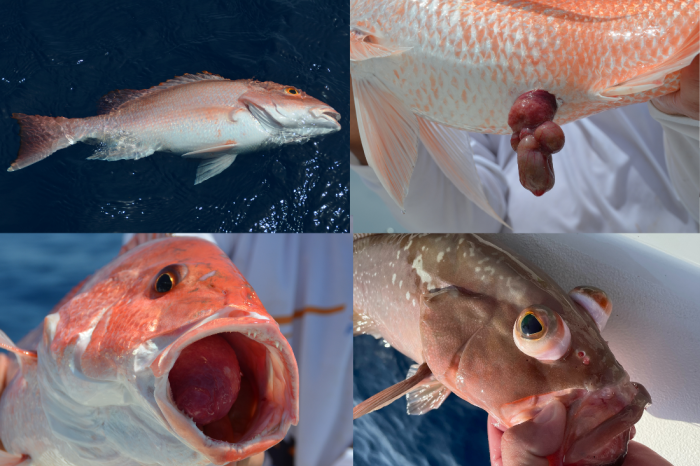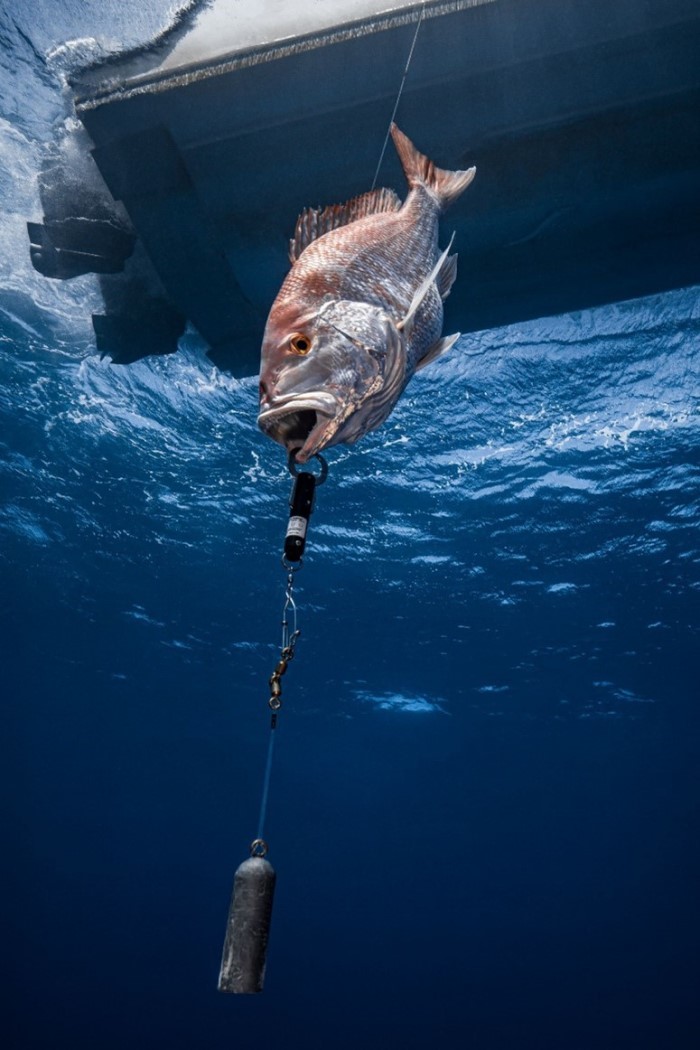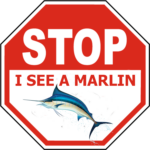If you’re fishing for reef fish this season, be sure to look for signs of barotrauma and be prepared to act. Barotrauma, or injuries caused by pressure changes, occur when fish are rapidly brought to the surface from depths 50 feet or greater. Signs of barotrauma include the stomach coming out of the mouth, bloated belly, distended intestines and bulging eyes. These injuries can be fatal to the fish unless intervention occurs through the use of descending devices or venting tools.

Signs of barotrauma include bloated belly, distended intestines, stomach coming out of the mouth and bulging eyes. Photos by Return ‘Em Right.
With the right tool and the right technique, all anglers should properly descend or vent a fish and give them a better chance at survival. When a fish survives release, it has another opportunity to reproduce and grow the population, leading to more fishing opportunities in the future.
Descending devices are tools with weights that attach to a fish and help take the fish back to the appropriate depth. There are various types of descending devices but the most common are lip clamps, inverted hooks and fish elevators. It is important to find the device that works best for you.
Before you go fishing, be sure to have your selected descending device ready for use. To properly descend a fish with a lip clamp or inverted hook, attach the descending device and weights to a heavy-duty rod and reel that is designated for descending or use a rope to handline the device and weights down and back up. A good goal is to use 1 pound of weight for every 5 pounds of fish being descended. Use a combination of loop knots, swivels, snaps, clips, etc. to attach the weights and device to your line. Be able to quickly and easily add or remove weights as needed, based on the size of the fish being descended and the water conditions. Unless you use a pressure-sensor device that releases fish automatically, you’ll need to jig your device to release the fish once the weights have brought it back down to depth.
To descend a fish with a fish elevator, simply send down the fish in a weighted container using a rope. This weighted container could be a crate, box or net that is turned upside down with an open top, so the fish can swim out on its own when it is returned to the bottom.
For short video tutorials on different types of descending devices, watch FWC’s Descending Devices playlist on YouTube.
Lip clamp descending device return fish to a depth where gases in the swim bladder can recompress. Photo by Return ‘Em Right.
Venting tools are sharp, hollow instruments that treat barotrauma by releasing expanded gas from the swim bladder, which enables the fish to swim back down to depth.
Items such as fillet knives, ice picks, screwdrivers and gaffs are not venting tools and should never be used to vent a fish. Venting a fish incorrectly can cause more harm than good.
To properly vent, lay the fish on its side (on a cool, wet surface). Venting tools should be inserted 2-3 inches behind the base of the pectoral fin, under a scale at a 45-degree angle, just deep enough to release trapped gasses. Never insert venting tools into a fish’s belly, back or stomach that may be protruding from the mouth. Learn how to vent properly by visiting Youtube.com/watch?v=jhkzv1_2Bpc.
Venting tools should be inserted 2-3 inches behind the base of the pectoral fin, under a scale at a 45-degree angle, just deep enough to release trapped gases. Photo by Return ‘Em Right.
Descending devices and venting tools should be used when fish show one or more signs of barotrauma. It is essential to work quickly when using these tools and return the fish to the water as soon as possible to give the fish the best chance at long-term survival. Studies have shown that the longer a fish is out of the water, the higher the mortality rate. Therefore, it is important to minimize handling time when descending or venting a fish with barotrauma. Anglers should choose the device and method they are most comfortable with that best fits the situation, and that follows reef fish gear requirements.
Reminder: When fishing for reef fish, descending devices and/or venting tools are required to be rigged and ready for use in Florida Gulf federal waters and descending devices are required to be on board and ready for use in Atlantic federal waters. Stay up to date with what is required in federal and state waters by visiting MyFWC.com/ReefFishGear and downloading the Fish Rules Fishing app for iOS or Android.
Remember to obtain your FREE State Reef Fish Angler designation before heading out! If you plan to fish for or harvest certain reef fish species in Gulf or Atlantic waters from a private recreational vessel (includes anglers over 65 years of age), you must sign up for this free designation and renew it annually. Learn more at MyFWC.com/SRFS and sign up today at GoOutdoorsFlorida.com or anywhere you can purchase a Florida fishing license.
Visit our YouTube channel at MyFWC.com/SaltwaterFishing for more saltwater fishing how-to videos. For answers to questions, contact 850-487-0554 or " target="_blank" rel="noopener">.
Source: When releasing reef fish, using the right tool with the right technique makes a difference
These Keys Treasures Designs and many more are available on products such as T-Shirts, Stickers, Magnets, Mugs, Phone Cases, and much more at KeysTreasures.ReBubble.com





